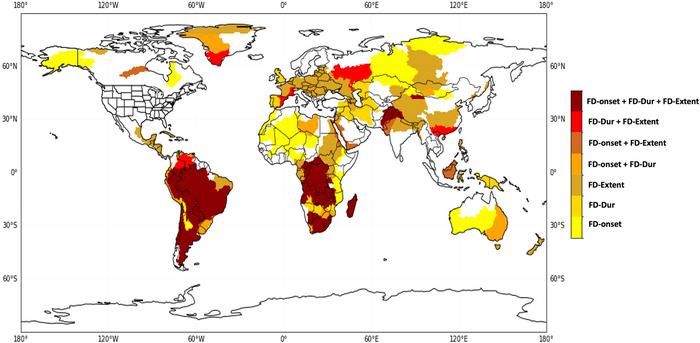WASHINGTON — Sudden, severe dry spells known as flash droughts are rising in intensity around the world, with a notable exception in mountainous Central Asia, where flash drought extent is shrinking, according to new research. Heat and changes to precipitation patterns caused by a warming climate are driving these trends, the study found.

Credit: Neelim and Hain (2024) Geophysical Research Letters
WASHINGTON — Sudden, severe dry spells known as flash droughts are rising in intensity around the world, with a notable exception in mountainous Central Asia, where flash drought extent is shrinking, according to new research. Heat and changes to precipitation patterns caused by a warming climate are driving these trends, the study found.
Flash droughts arrive suddenly, within weeks, hitting communities that are often not prepared and causing lasting impact. They are an emerging concern for water and food security. The new study is the first to apply a systematic, quantitative approach to the global incidence of flash drought, mapping hotspots and regions of rapid increases in recent decades.
“For many parts of the world, we saw flash droughts extending over larger areas, for longer time, with faster onset speed,” said Maheshwari Neelam, a climate scientist at NASA’s Marshall Space Flight Center and the Universities Space Research Association. She is the lead author of the study, published in Geophysical Research Letters, AGU’s journal for high-impact, short-format reports with immediate implications spanning all Earth and space sciences.
The study defined and tracked three critical measures of drought severity: speed of onset, duration and geographic extent. It analyzed 40 years of NASA’s MERRA-2 climate data, from 1980 to 2019, drawn from weather observations, satellite imagery and modeled root-zone soil moisture, with the aim of improving prediction and disaster preparedness.
“For example, in watersheds in South America, onset is getting faster by about 0.12 days per year, so over a decade they are developing a day earlier. Extent is increasing by 1 to 3% per year,” Neelam said. “The metrics can be used by early warning systems to incorporate rates of change in flash drought characteristics in risk assessment and disaster preparedness.”
South America, particularly southern Brazil and the Amazon, is experiencing strong intensification in all three dimensions of flash drought, aligning with deforestation patterns in the region, high temperatures and less rain. Congo, Angola, Zambia, Zimbabwe, South Africa, Lesotho, and Madagascar are also hotspots. High temperatures were found to be more important than declining precipitation in the African watersheds.
Land cover is also important to flash drought vulnerability. Savanna and grasslands are more susceptible to flash droughts than other ecotypes, particularly in humid and semi-humid climates, the study found.
In Central Asian watersheds, centered on high mountains, including the Himalaya Karakoram, Tianshan and Hindu Kush, flash drought extent shrank over the study period, bucking the worldwide trend. Climate-driven changes in precipitation, melting snowpack and a shift from snow to rain in the mountains have kept soils moist. These changes can cause an increase in flash floods, which have been observed in the region, Neelam said.
Neelam emphasized the importance of understanding landscapes’ response to disasters on a watershed scale for assessing water budgets and water management, transcending geopolitical boundaries.
“Natural hazards have no political values,” Neelam said. “This is why we looked at watersheds and not countries.”
#
Notes for journalists:
This study was published in Geophysical Research Letters, an open-access AGU journal. Neither the study nor this press release is under embargo. View and download a pdf of the study here.
Interview requests should be directed to the researchers and their press offices.
This work was supported by the NASA Research and Analysis Program, Weather and Atmospheric Dynamics Focus Area as part of the SPoRT project at Marshall Space Flight Center.
Paper title:
“Global Flash Droughts Characteristics: Onset, Duration, and Extent at Watershed Scales”
Authors:
- Maheshwari Neelam (corresponding author) Universities Space Research Association and NASA Marshall Space Flight Center, Earth Science Branch, Huntsville, AL, USA
- Christopher Hain, NASA Marshall Space Flight Center, Earth Science Branch, Huntsville, AL, USA
###
AGU (www.agu.org) is a global community supporting more than half a million advocates and professionals in Earth and space sciences. Through broad and inclusive partnerships, AGU aims to advance discovery and solution science that accelerate knowledge and create solutions that are ethical, unbiased and respectful of communities and their values. Our programs include serving as a scholarly publisher, convening virtual and in-person events and providing career support. We live our values in everything we do, such as our net zero energy renovated building in Washington, D.C. and our Ethics and Equity Center, which fosters a diverse and inclusive geoscience community to ensure responsible conduct.
#
To subscribe or change your emailing preferences for the AGU Newsroom, click here.
Journal
Geophysical Research Letters
Method of Research
Data/statistical analysis
Subject of Research
Not applicable
Article Title
Global Flash Droughts Characteristics: Onset, Duration, and Extent at Watershed Scales
Article Publication Date
16-May-2024



